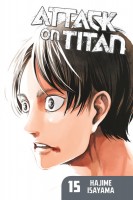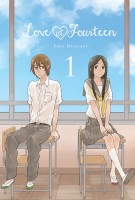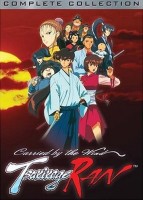My News and Reviews
Well, I was hoping to post the recap of my recent visit to the Toronto Comic Arts Festival last week, but I haven’t actually managed to finish writing it yet. (Things have been very busy at work and home, and the taiko performance season is ramping up, too.) So, the plan is to post it sometime later this week instead. Fortunately, I did have a couple of in-depth manga reviews in reserve for last week just in case the TCAF post fell through. The first review, Yuki Urushibara’s Mushishi, Volume 3, is a part of my ongoing monthly horror manga review project. Mushishi continues to be one of my favorite series. This particular volume is notable as it reveals some of Ginko’s backstory. Last week I also reviewed the most recent installment of Bruno Gmünder’s Gay Manga line, Mentaiko Itto’s Priapus, which is a highly entertaining collection of gay erotic manga. The volume marks Itto’s official English-language debut and contains some pretty ridiculous stories and characters.
While I haven’t managed to fully report back on TCAF 2015, other TCAF posts are already being made. The Comics Reporter is making an effort to create an index of stories and references, but I specifically wanted to point out the recordings of some of the panels at The Comics Beat. Other items of interest from elsewhere online include Ryan Holmberg’s most recent What Was Alternative Manga? column at The Comics Journal—Blood Plants: Mizuki Shigeru, Kitaro, and the Japanese Blood Industry—and the 2015 edition of Advice on Manga Translation from Manga Translators over at Organization Anti-Social Geniuses. As for licensing news, Kodansha Comics announced a deluxe omnibus edition of Fairy Tail and Dark Horse will be adding a few new titles: Kentaro Miura’s Giganto Maxia, Spike Chunsoft and Takashi Tsukimi’s Danganronpa, and Kengo Hanazawa’s I Am a Hero, in addition to rescuing CLAMP’s RG Veda.
Quick Takes
 Attack on Titan, Volume 15 by Hajime Isayama. Although it certainly has its moments and its own peculiar charm, Isayama’s artwork has never really been one of the strengths of Attack on Titan. There has certainly been improvement over the course of the series, and some of the individual panels and sequences are fantastic, but the artwork in this particular volume is terribly inconsistent and sometimes doesn’t even make sense to the point of distraction. But what Attack on Titan lacks in artistic finesse, the series makes up for with its large, engaging cast of characters and its constantly evolving story. Granted, with plot twist after plot twist after plot twist, the story is frequently on the verge of getting out of hand. Fortunately, Isayama reins it in a bit with this volume, allowing several of the story threads to play out and come to some sort of resolution before throwing something completely new into the mix, once again ending with a cliffhanger. Sometimes I miss the days when Attack on Titan was closer to being straight up horror, but all of the recent political intrigue can be interesting, too.
Attack on Titan, Volume 15 by Hajime Isayama. Although it certainly has its moments and its own peculiar charm, Isayama’s artwork has never really been one of the strengths of Attack on Titan. There has certainly been improvement over the course of the series, and some of the individual panels and sequences are fantastic, but the artwork in this particular volume is terribly inconsistent and sometimes doesn’t even make sense to the point of distraction. But what Attack on Titan lacks in artistic finesse, the series makes up for with its large, engaging cast of characters and its constantly evolving story. Granted, with plot twist after plot twist after plot twist, the story is frequently on the verge of getting out of hand. Fortunately, Isayama reins it in a bit with this volume, allowing several of the story threads to play out and come to some sort of resolution before throwing something completely new into the mix, once again ending with a cliffhanger. Sometimes I miss the days when Attack on Titan was closer to being straight up horror, but all of the recent political intrigue can be interesting, too.
 Fairy Tail, Volumes 47-48 by Hiro Mashima. Thanks to Mashima’s afterword in the forty-seventh volume, I think I’ve finally figured out why Fairy Tail has been frustrating me recently—it’s his admitted lack of foreshadowing. The sudden plot developments that seem to come out of nowhere, although some of them are admittedly pretty great, make the series feel very disjointed and to some extent even directionless. Instead of inspiring feelings of excitement in how the story is progressing, Fairy Tail often inspires bafflement over its twists and revelations. In the same afterword Mashima indicates that he hopes to improve the foreshadowing, but he also says that he’ll be including plenty of red herrings as well, so I’m not sure how much that’s going to help. But even considering the unevenness of the series’ narrative, there’s still some good fun to be had in these two volumes. There are dragons, epic battles, and plenty of opportunities for the characters to demonstrate just how powerful they have become and just how badass they can be. Mashima is even able to work in some additional backstory for some of the characters amidst all the chaos.
Fairy Tail, Volumes 47-48 by Hiro Mashima. Thanks to Mashima’s afterword in the forty-seventh volume, I think I’ve finally figured out why Fairy Tail has been frustrating me recently—it’s his admitted lack of foreshadowing. The sudden plot developments that seem to come out of nowhere, although some of them are admittedly pretty great, make the series feel very disjointed and to some extent even directionless. Instead of inspiring feelings of excitement in how the story is progressing, Fairy Tail often inspires bafflement over its twists and revelations. In the same afterword Mashima indicates that he hopes to improve the foreshadowing, but he also says that he’ll be including plenty of red herrings as well, so I’m not sure how much that’s going to help. But even considering the unevenness of the series’ narrative, there’s still some good fun to be had in these two volumes. There are dragons, epic battles, and plenty of opportunities for the characters to demonstrate just how powerful they have become and just how badass they can be. Mashima is even able to work in some additional backstory for some of the characters amidst all the chaos.
 Love at Fourteen, Volumes 1-2 by Fuka Mizutani. I was actually taken by surprise by how much I ended up enjoying the first two volumes of Love at Fourteen. I had heard good things about the series, but I didn’t really expect that I would be so taken with a series about the romantic turmoils of middle school students. Tanaka and Yoshikawa have been close friends for some time and that friendship has started to blossom into something greater. They are becoming more aware of themselves and of each other. But their school doesn’t allow dating at such a young age, so they do what they can to keep their relationship a secret. So far the series is a chaste, slowly developing romance, but realistically that’s how it should be. Love at Fourteen is charming and somewhat nostalgic without being syrupy sweet. There’s even some queer representation—a girl who has fallen in love with another girl—which I’m always happy to see. However, I will admit that I am a little concerned about how the relationship between the music teacher and one of the other students may develop since some of her behavior towards him has been has been borderline if not blatantly inappropriate.
Love at Fourteen, Volumes 1-2 by Fuka Mizutani. I was actually taken by surprise by how much I ended up enjoying the first two volumes of Love at Fourteen. I had heard good things about the series, but I didn’t really expect that I would be so taken with a series about the romantic turmoils of middle school students. Tanaka and Yoshikawa have been close friends for some time and that friendship has started to blossom into something greater. They are becoming more aware of themselves and of each other. But their school doesn’t allow dating at such a young age, so they do what they can to keep their relationship a secret. So far the series is a chaste, slowly developing romance, but realistically that’s how it should be. Love at Fourteen is charming and somewhat nostalgic without being syrupy sweet. There’s even some queer representation—a girl who has fallen in love with another girl—which I’m always happy to see. However, I will admit that I am a little concerned about how the relationship between the music teacher and one of the other students may develop since some of her behavior towards him has been has been borderline if not blatantly inappropriate.
 Carried by the Wind: Tsukikage Ran directed by Akitaro Daichi. I am just now discovering Carried by the Wind; I completely missed when it was first released and happened across the thirteen-episode series more by accident than anything else. I’m glad that I did, though, because it is a tremendous amount of fun. Carried by the Wind is a comedic homage, without quite being a parody, of samurai films and television series. Tsukikage Ran, a skilled swordswoman, is a wandering ronin who would much rather drink a good bottle of sake and take a nap than get into a fight. Meow is a talented Chinese martial artist who means well but tends to get herself into trouble with her meddling. Although their attitudes and personalities are almost complete opposites—Ran is cool and collected while Meow is brash and prone to outbursts—the two end up becoming traveling companions of sorts. Each episode of Carried by the Wind stands completely on its own and generally follows a somewhat predictable story arc with Ran and Meow righting some sort of wrongdoing. But with its humor, marvelous lead characters, and great fight scenes, Carried by the Wind is a highly entertaining series.
Carried by the Wind: Tsukikage Ran directed by Akitaro Daichi. I am just now discovering Carried by the Wind; I completely missed when it was first released and happened across the thirteen-episode series more by accident than anything else. I’m glad that I did, though, because it is a tremendous amount of fun. Carried by the Wind is a comedic homage, without quite being a parody, of samurai films and television series. Tsukikage Ran, a skilled swordswoman, is a wandering ronin who would much rather drink a good bottle of sake and take a nap than get into a fight. Meow is a talented Chinese martial artist who means well but tends to get herself into trouble with her meddling. Although their attitudes and personalities are almost complete opposites—Ran is cool and collected while Meow is brash and prone to outbursts—the two end up becoming traveling companions of sorts. Each episode of Carried by the Wind stands completely on its own and generally follows a somewhat predictable story arc with Ran and Meow righting some sort of wrongdoing. But with its humor, marvelous lead characters, and great fight scenes, Carried by the Wind is a highly entertaining series.

[…] Review Links: Jason Thompson offers a sneak peak at cyber-thriller Inuyashiki, which will debut in print this August, while Serdar Yegulalp revisits old favorite Black Lagoon. At Brain vs. Book, translator Jocelyn Allen discusses Aya Kanno’s Otomen. (Fun fact: Allen is currently translating Kanno’s Requiem of the Rose King for VIZ.) Closer to home, Sean Gaffney posts an early review of The Ancient Magus’ Bride, while Ash Brown weighs in on the latest volumes of Attack on Titan, Fairy Tail, and Love at 14. […]